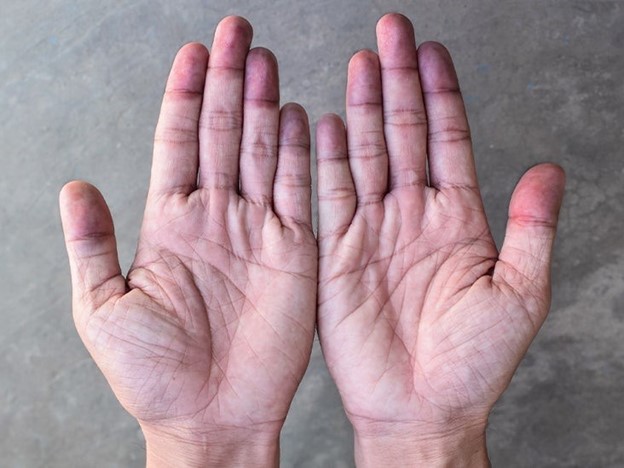A nurse is performing a skin assessment on a client who has dark skin.
Which of the following locations on the client’s body should the nurse observe to assess for cyanosis?
Area of trauma.
Sacrum.
Shoulders.
Palms of the hands.
The Correct Answer is D

Cyanosis is a bluish discoloration of the skin and mucous membranes due to inadequate oxygenation of the blood. It is more difficult to detect in people who have dark skin, so the nurse should look for cyanosis in areas where the skin is thinner and the blood supply is richer, such as the palms of the hands, the lips, the gums, and around the eyes.
These areas are less affected by melanin, the pigment that gives skin its color.
Choice A is wrong because an area of trauma may have bruising or inflammation that can mask cyanosis.
Choice B is wrong because the sacrum is not a good site to assess for cyanosis in any skin tone, as it is prone to pressure ulcers and poor circulation.
Choice C is wrong because the shoulders are not a mucous membrane and may have more melanin than other areas of the body.
Nursing Test Bank
Naxlex Comprehensive Predictor Exams
Related Questions
Correct Answer is D
Explanation
The correct answer is choice D. The nurse should determine if the client’s health care surrogate is aware of the risks and benefits of the procedure. A health care surrogate is a person who is authorized to make health care decisions for a client who is unable to do so. The nurse has a legal and ethical responsibility to ensure that the client’s surrogate has given informed consent for the surgery, which means that they have received adequate information about the procedure, its purpose, its risks, its benefits, and its alternatives.
Choice A is wrong because sending the unsigned informed consent form to the facility’s risk manager does not ensure that the client’s surrogate has given informed consent. The risk manager is not involved in the consent process and cannot authorize the surgery without the surrogate’s consent.
Choice B is wrong because ensuring that the client’s family supports the provider’s decision for surgery is not the same as obtaining informed consent from the surrogate.
The family may have different opinions or preferences than the surrogate, and the surrogate may not agree with the provider’s decision. The nurse should respect the surrogate’s autonomy and authority to make decisions for the client.
Choice C is wrong because determining if the procedure is medically necessary for the client is not the nurse’s role.
The provider is responsible for determining the medical necessity of the surgery and explaining it to the surrogate. The nurse should not question or interfere with the provider’s judgment unless there is evidence of negligence or malpractice.
Correct Answer is D
Explanation
The correct answer is d. Evaluate functioning of the suction device.
Choice D rationale:
- Prompt assessment of the suction device is crucial to determine if it's functioning properly.If the suction is inadequate,it can lead to gastric contents accumulating and potentially causing vomiting.
- Assessing the suction device first allows for timely interventionif it's not working correctly,preventing further complications and discomfort for the client.
Choice A rationale:
- Replacing the NG tube might be necessary if it's dislodged or blocked, but it shouldn't be the immediate action.
- Evaluating the suction device first can help determine if the NG tube itself is the issue or if the problem lies with the suction.
Choice B rationale:
- Providing oral hygiene care is important for comfort and to prevent aspiration, but it's not the priority intervention in this situation.
- Addressing the cause of the vomiting, which could be related to suction malfunction, takes precedence.
Choice C rationale:
- Administering an antiemetic might be helpful to control nausea and vomiting, but it doesn't address the underlying cause.
- Evaluating the suction device first is essential to ensure proper gastric decompression and prevent further vomiting episodes.
Whether you are a student looking to ace your exams or a practicing nurse seeking to enhance your expertise , our nursing education contents will empower you with the confidence and competence to make a difference in the lives of patients and become a respected leader in the healthcare field.
Visit Naxlex, invest in your future and unlock endless possibilities with our unparalleled nursing education contents today
Report Wrong Answer on the Current Question
Do you disagree with the answer? If yes, what is your expected answer? Explain.
Kindly be descriptive with the issue you are facing.
